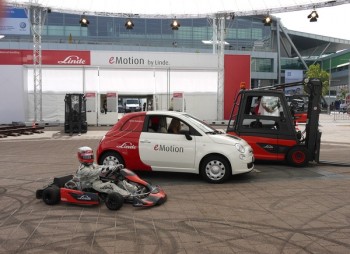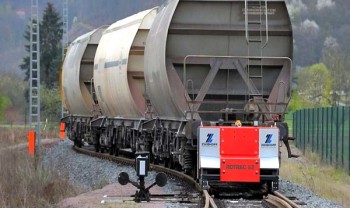40 years of Linde electric forklifts trucks – A success story that started as the diesel truck’s little brother
40 years of Linde electric forklifts trucks and electric drive expertise
The product launch of the new E20 to E50 electric forklift trucks at CeMAT 2011 marked the latest highlight in the history of the Linde E-forklift. Linde Material Handling introduced the first battery-operated forklift under the Linde brand at the 1971 trade fair in Hanover. Since then, Linde MH has built millions of electric drive systems, each one tried and tested in the daily heavy duty operation of mobile working machines and continuously advanced over the course of time. Today, 40 years later, the company is not only the leading manufacturer of electric forklift trucks in Europe, but under the label ‘eMotion’ Linde also offers this know-how to external customers for a variety of applications through its Electronic Systems & Drives (ES&D) unit.
When Linde began to produce E-forklifts at the beginning of the 1970s, its range expanded to include products for special areas of application. E-forklifts were the noiseless and emissions-free alternative to IC trucks. At first the E-forklift could not compete with the market success of their conventional IC brothers. But that all changed with three ground-breaking technological innovations. At the beginning of the 1980s, power electronics were introduced, which allowed more precise control over the electronic motors. The differences between the E-forklifts and IC trucks in terms of lifting capacity, lifting speed and turnaround time became fewer and sales increased. The market also grew with an increasing number of distribution centres and warehouses.
This trend continued until the next technical innovation in 1995: the electrical control system of the lift mast functions with a joystick, called Linde Load Control. This special equipment soon developed into an industry standard, offering extremely sensitive controls at the tip of your fingertips. 2002 saw another milestone with the transition from parallel or shunt motors to asynchronous three-phase motors. Consequently Linde E-forklifts now offer similar performance to IC trucks. The industrial truck sector keeps a close eye on the automotive industry, which has given it a significant head start when it comes to electronic drives. Whereas electric cars are only slowly gaining in popularity among consumers, intralogistics would be unthinkable without battery-powered forklifts.
This backlog was one of the considerations behind the decision to open up new markets by offering the know how in developing and producing electric drive systems to new customer groups: Since 2010 Linde’s Electronic Systems & Drives (ES&D) unit, based on its engineering experience and systems expertise, combines proven electric ,electronic and mechanic components – taken from the serial production of forklift trucks – into efficient, comprehensive solutions which perfectly fit the customer’s requirements, also in terms of energy efficiency and cost effectiveness. This is beneficial in both ways: Lessons learned and detailed solutions deriving from this process are fed back into the development of the next generation of industrial trucks.
A number of impressive examples demonstrate the capabilities of ES&D:

Photo by Linde Material Handling GmbH
Karabag New 500 E: zero emissions at competitive prices
The Karabag New 500 E is based on a Fiat 500 and uses economical and highly efficient electric drives with a comparatively inexpensive lithium-polymer battery. Karabag was supported in the design and optimisation of these drives by ES&D. When their collaboration with Karabag began, the basic concept already in place left room for optimisation. The drive specialists replaced the original plan for a nominal 30 kW cooled drive with a far lighter, uncooled 28-kW motor and optimised the functions of the electronic control unit. As a result, the Karabag New 500 E comfortably outperforms the older, supposedly more powerful, version. In addition to the drive unit for this project, ES&D is supplying a package consisting of the motor, converter, fan and control unit. The LINC 1 control unit communicates with the on-board computer, the battery management system (BMS), a gateway and the instrument panel display.
The result of this joint development project is a vehicle with a top performance of 28 kW that can reach speeds of up to 105 km/h and accelerate from 0 to 50 km/h in 8.5 seconds. Furthermore, its cruising range of 100 km makes it perfectly suited to meet urban mobility needs. Just as impressive as these statistics is the cost comparison with a FIAT 500 with a combustion engine. Karabag has calculated that a FIAT series model incurs total costs of €412 per month, while the Karabag New 500 E will cost only €370.40, based on the monthly leasing fee of €299 with no special payment and with a four-year guarantee.
World Record Technology by Linde – Linde E1 electric kart earns entry in Guinness Book of Records
From 0 to 60 mph in just 3.45 seconds – this was the new world record set by the “Linde E1” electric kart developed by Linde’s ES&D unit. By producing more acceleration than any other electric vehicle in the world has ever done before, racing driver Andreas Wolf launched the e-kart into the Guinness Book of World Records. Based on a racing chassis of kart class KZ 1&2 and equipped with standard components that are also found in the new electric counterbalance lift trucks Linde E20 to E50, the Linde E1 can leverage the full power of Linde drive technology.
Performance data of the Linde E1
- Chassis: Racing chassis for kart class KZ 1&2 incl. brake system
- Overall weight: Approx. 160 kg (excl. driver)
- Power transmission: Chain, ratio 1:2.3
- Motor: Series motor Linde BR387, asynchronous machine; max. torque approx. 150Nm
- Inverter: Series module Linde BR387, 120V max.,peak power 600A AC
- Drive control: Series control unit Linde BR387 , LDC70
- Battery: Li-Ion, 96V rated voltage, peak power approx. 50kW
- Driving performance: Max. acceleration approx. 1.2 g (1.0 = free fall)
- 0 to 60 mph (96.56 km/h) in 3.45 seconds)
- Maximum speed: Approx. 120 km/h

ROTRAC E2 and E4
Photo by Linde Material Handling GmbH
ROTRAC E2 and E4: compact powerhouses for heavyweight jobs
The role of these mobile machines is to move locomotives and carriages, for example in loading stations or repair yards. This requires high tractive force, and the vehicles must also be able to move on and off rails – hence the name “road-rail shunter“. Thanks to the amount of torque generated by the electric four-wheel drive and the perfectly adjustable contact pressure on the rails due to its moving guide rollers, the extremely compact ROTRAC E2 can tow 250 tonnes without any difficulty. And when off the rails, the electronic four-wheel/live-axle steering enables it to manoeuvre freely on asphalt with a turning radius of only 0.9 metres. This innovative drive concept, unique in the railway technology sector, can be realised with serial equipment manufactured by Linde Material Handling. Two drive axles with two integrated electric motors each are used. Their regulated braking characteristics allow for high levels of energy recovery through recuperation. About one year after the successful market launch of the Rotrac E2, the Rotrac E4 was presented. With 500 tonnes in rail operation, the Rotrac E4 has double the tractive power of its sister model. As a result, the truck, which is extremely compact despite its net weight of 7.5 tonnes, can even move the new generation of ICE 3 high-speed trains that will be brought into service in summer 2013.
Airport container loaders: Electric drives replace diesel engines
Every day at Munich Airport there are roughly 1,100 take-offs and landings – with over 900 tonnes of baggage that have to be moved reliably and safely. Since 2011 the operator has been using the Laweco Green Line Cargo Master container loader that is not driven by a conventional diesel engine, but two Linde electric motors in combination with state-of-the-art electronics and powerful hydraulics.
This concept provides a whole range of benefits: The “ultra-slow” function provided by the hydraulic motor ensures accurate positioning at the fuselage. The energy released when the load is lowered can also be fed back into the battery. At a maximum lift height of 3.70 m and a load capacity of up to 7000 kg, a significant amount of energy is recovered. The cargo lifter operates at a very low noise level, and has no need for the conventional idle operation mode required by the diesel engine. The two motors are switched on separately as required, meaning they only consume energy when the drive and operating functions are actually being used.
Thus, the operator benefits from low running costs and significantly improved environmental friendliness compared to diesel-powered vehicles. In fact, because of saving 7800 litres of diesel per year the annual operating costs are less than half those of a conventional vehicle, while noise and exhaust emissions are eliminated altogether.
News Categories
- » NEWS HOME
- » Automation & Robotics
- » Industry 4.0
- » Material Handling
- » Sensors
- » Quality & Testing
- » Machine Vision
- » Laser & Optics
- » Metalworking
- » Motion Control & Drives
- » Hydraulics & Pneumatics
- » Process Industry
- » Renewable Energy
- » Agriculture
- » Home & Office Furniture
- » Additive Manufacturing
- » Environmental Tech



